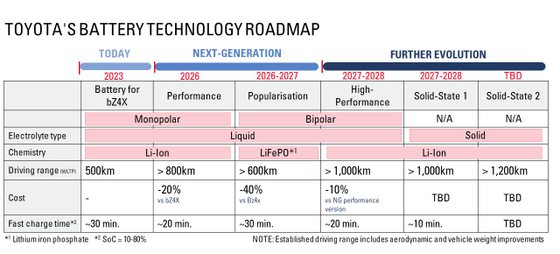Toyota, the largest vehicle manufacturer in the world, “woke up” late with 100% electric vehicles, but (finally) seems willing to make an investment in this technology compatible with the size of the giant it is. At the moment, the only 100% electric model of the Japanese brand is the bZ4X SUV and this was precisely the comparative term with which it revealed what it has prepared for the future. In the pipeline is a “new generation of battery electric vehicles (BEV), which will be accompanied by improvements in construction, aiming for lower weight and (certainly) more contained production costs. But the news does not stop there, quite the opposite, since the Japanese manufacturer revealed the plan it has drawn up for the development of batteries, with ranges of between 800 and 1,200 km.
For starters, don’t be fooled if you thought this trailer was just around the corner. It will still be necessary to wait at least three years to see the first results of Toyota’s strategy. If the schedule presented by the brand is met, only in 2026 will we be able to have the first element of the new generation of Toyota BEVs on the road. This was confirmed by the president of Toyota’s BEV factory, Takero Kato, according to which 1.7 million of the 3.5 million battery-only models that Toyota expects to sell between now and 2030 will be of the next generation.
To meet this objective, Toyota is committed to batteries for all tastes: three focus on conventional liquid electrolyte batteries, with the aim of “providing greater power, greater autonomy, faster charging and lower cost”, and the fourth highlights the focus in long-lasting batteries. long-awaited solid state technology. This will be the one that could put Toyota trams into circulation with up to 1,200 km of autonomy, something that will only happen in 2027/28. The brand changed its plans in this regard, since what was initially planned was to incorporate solid batteries into conventional hybrids. The focus has changed and “is now primarily focused on next-generation BEVs,” and the brand shows some enthusiasm for having come to the conclusion that the longevity of this type of battery will not be a drawback. “Until now, the expectation was that the battery life would be shorter. However, Toyota’s recent technological advancements have overcome this challenge and the company has shifted its focus toward mass production of solid-state batteries,” the brand states. According to her, the first solid-state battery to be launched commercially should be able to go from 10 to 80% of its capacity in 10 minutes or less of fast charging.

Source: Toyota
Batteries in liquid state. What to expect?
Without giving up solid-state batteries, which represent an enormous gain in terms of volume, that is, they are more compact and at the same time less prone to fires, Toyota is focusing on the most immediate: the development of liquid electrolyte batteries.
With this technology, you have to expect three types of batteries. Offering will begin in 2026 with a battery called “Performance Li-Ion,” which is expected to provide “more than 800 km of range when combined with improved aerodynamics and reduced vehicle weight.” According to the brand, this type of battery will be able to go from 10 to 80% of its capacity in less than 20 minutes at a fast charging station, without the brand specifying DC power. Also according to Toyota, the introduction of the Performance Li-Ion will mean a 20% cost reduction, compared to the bZ4X.
At the same time or no later than a year later, in 2027, the time has come for consumers to have the option of batteries with a different and even cheaper chemistry. These are the so-called “Popularization”, batteries that use lithium iron phosphate (LiFePO) to reduce costs. And the reduction can reach 40% compared to the current bZ4X, with gains of 20% in autonomy between visits to a charging point. As for fast charging, it takes a little longer (10 to 80% in half an hour or less).
In 2027/2028, Toyota hopes to bring high-performance batteries to the market, which will combine the brand’s bipolar technology with lithium ions and a “high nickel content cathode”, to offer a range of more than 1,000 km. With the double advantage that, compared to Performance Li-Ion batteries, autonomy increases and costs drop by 10%.
Flatten for autonomy
The Japanese believe that the way to extract greater efficiency from the battery pack is to flatten it. “If the height of the battery can be reduced, obviously the overall height of the vehicle can be reduced, the aerodynamic coefficient multiplied by the frontal area (CdA) can be improved and the overall range can be increased,” Toyota argues. In this sense, the brand intends to go from the 15 cm in height that we find in the bZ4x pack to 12 or even 10 cm, in electric sports cars, where the low center of gravity is decisive for more efficient behavior.
Source: Observadora
